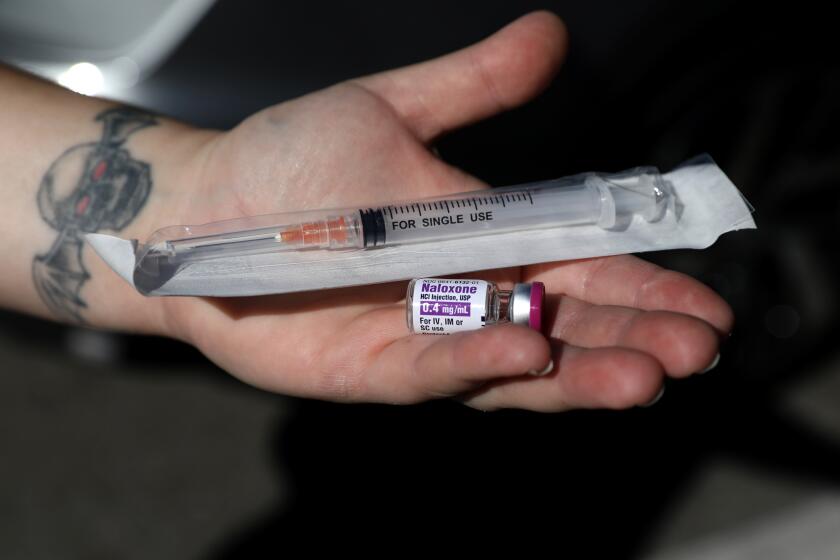A tough diagnosis that’s more difficult with youth
Christina Shimek is only 17, but she has already had more pain than many adults have in a lifetime.
She woke up one morning a year ago, she says, “in excruciating pain in my lower back and pelvic area. I was in tears.” Frantic, her parents took her to the hospital, where doctors assumed the trouble was her appendix and took it out.
The appendix was normal, however -- and the pain persisted. The Leominster, Mass., teenager missed school for four months, had to repeat chemistry and missed an important rite of passage, her “junior ring ceremony” in which students get their class rings. She went to two doctors, who “were both baffled,” she said. Finally, a nurse suggested endometriosis, a diagnosis confirmed by surgery.
Historically, endometriosis -- in which tissue from the lining of the uterus, called the endometrium, escapes and lodges in other areas -- has been thought of as a problem of adult women. According to the National Institutes of Health, 5.5 million women in North America have endometriosis; there is no cure, but pregnancy can sometimes trigger a lasting remission and the disease often gets better at menopause. The disease causes infertility in 30% to 40% of women who have it.
Two-thirds of adults with endometriosis began getting symptoms before age 20, and endometriosis is increasingly being found in young women as well.
It’s hard enough for any woman, adult or teenager, to get a correct diagnosis of endometriosis because there are so many other causes of abdominal pain, including appendicitis, bowel disease and pelvic inflammatory disease. In fact, it takes an average of nine years for most adult women to get a correct diagnosis, according to a review paper published last year by the American College of Obstetricians and Gynecologists.
But while adult women typically have two to three doctor visits before they get diagnosed, it takes more than four visits on average for teens whose symptoms began before age 15, partly because endometriosis in young women is still not on the radar screen for many doctors.
And teenagers themselves often put off seeing a doctor for fear they will get a pelvic exam, in which the doctor inserts a finger or metal instrument into the vagina to feel the cervix and ovaries. “Some kids are so afraid of a pelvic exam they won’t even get out of the car,” said Dr. Marc Laufer, chief of gynecology at Children’s Hospital Boston and lead author of the review paper. Doctors sometimes use ultrasounds on girls uncomfortable with pelvic exams.
Nobody knows why endometriosis occurs -- it may be from menstrual blood flowing backward and into the abdomen, from endometrial cells migrating to the wrong place during fetal development, from normal cells in the pelvis turning into endometrial cells, or for some other genetic, immunologic or environmental reason. This aberrant tissue then causes painful scarring and bleeding, because it responds to the same monthly hormones as the uterine lining itself. (In rare cases, endometrial tissue even winds up in the nose, triggering monthly nosebleeds.)
Slowly, doctors are getting a better handle on how to treat endometriosis in young women, though the treatments don’t always work.
The first line of attack is continuous use of birth control pills containing the hormones estrogen and progestin to shut down ovulation and stop periods, said Dr. Meredith Loveless, who runs the pediatric and adolescent gynecology service at Johns Hopkins University. Nonsteroidal anti-inflammatory medications like Motrin or Advil can help control the pain.
If these approaches don’t help, laparoscopic surgery -- in which doctors insert instruments through tiny incisions -- is the next step. The endometriosis lesions, or areas, are then cut out or destroyed.
To make sure they don’t grow back, doctors prescribe more hormones, either birth control pills or a drug called Lupron, which shuts down ovulation. Because Lupron triggers hot flashes and mood swings and interferes with the formation of bones at the time of peak bone growth, doctors don’t use it for girls younger than 16. For older teens, they give Lupron with “add-back” hormones -- small doses of estrogen and progestin to prevent these side effects.
“The hope is that by treating young women with endometriosis earlier, we can get better outcomes in terms of both pain and fertility,” said Dr. Claire Templeman, an assistant professor of obstetrics, gynecology and surgery at USC. “But so far, there’s no data on long-term outcomes.”
Things have not worked out well for Shimek: “Now I know what I have, but the pain is still there,” she said.
Despite surgery and Lupron, there are still “days I just can’t go to school because it hurts too much.”
And she’s still haunted by the threat of infertility. “I want children. That’s the most important thing. I would be devastated if I couldn’t.”



